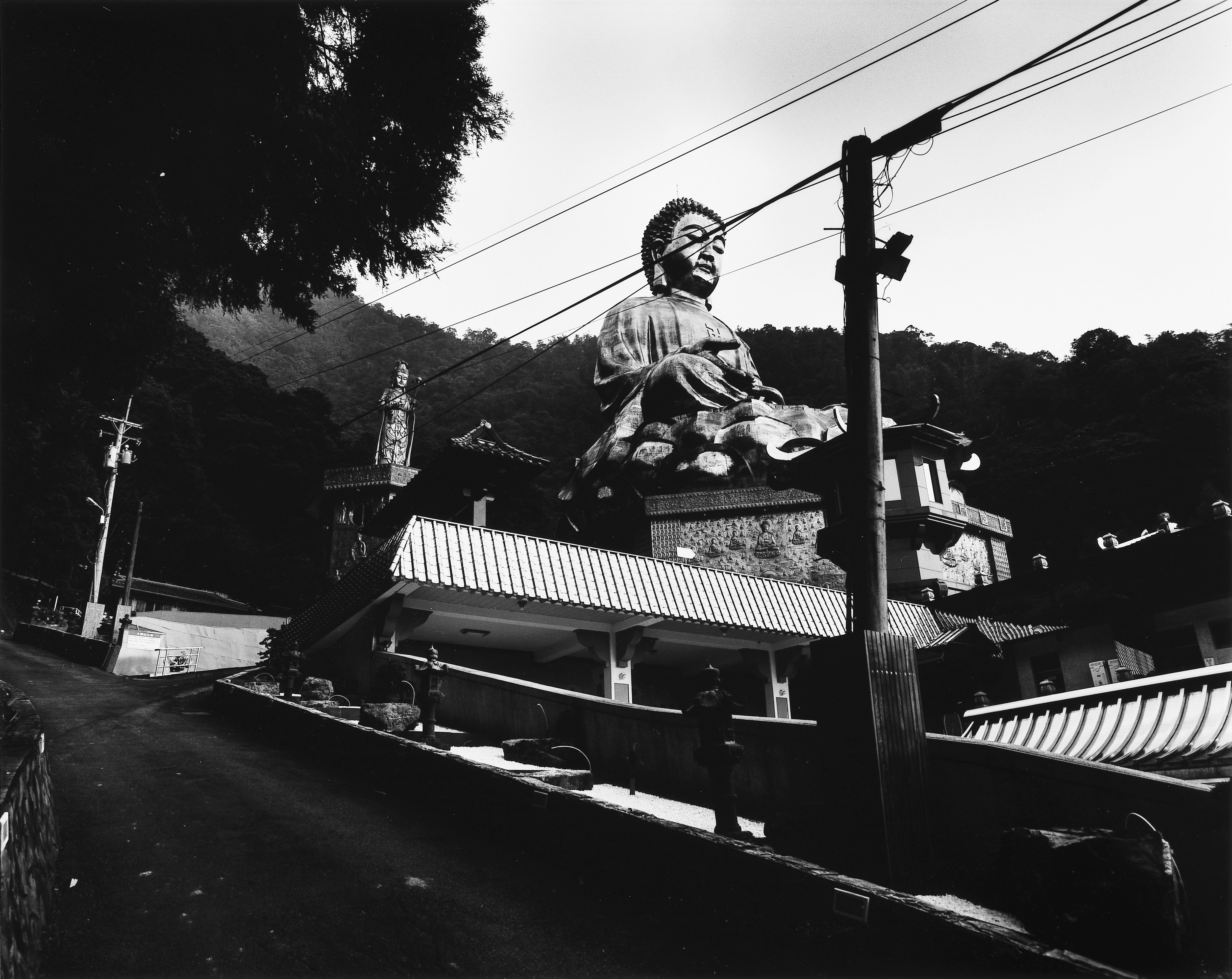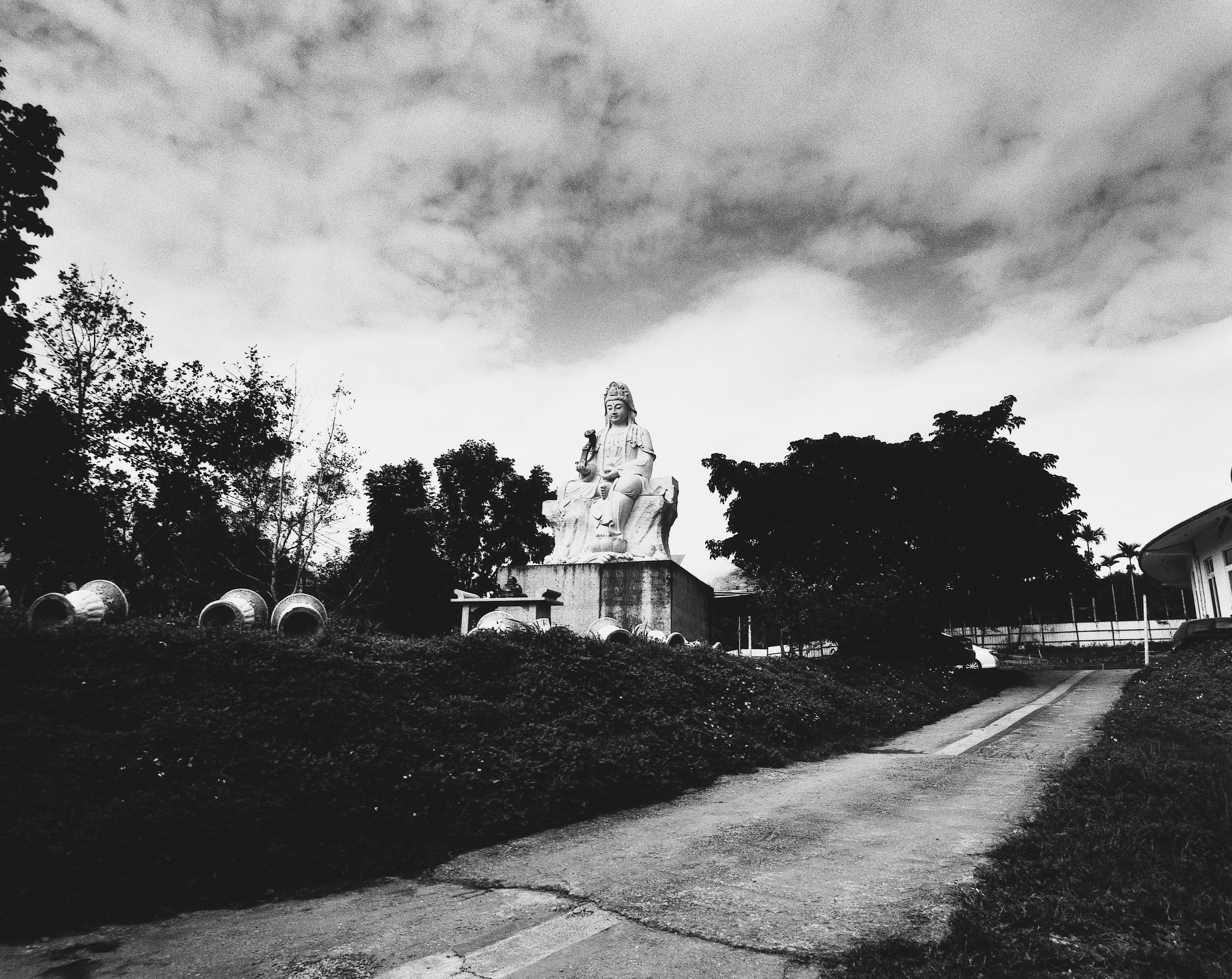《巨神連線》系列攝影作品主要自2016年初開拍,歷經一年半,密集拍攝全台230餘間廟宇、墓園、公園及樂園,主要關注漢人用自我形象所投射而形塑出來的神偶世界,透過這些欲望投射物進而了解地理空間上的特殊政治性關係。
姚瑞中跳脫「活動」、「祭典」或「人物」的場景,只專注於信徒們膜拜的「巨大欲力投射」,也就是神明的具體形象,偏向類型學景觀式攝影而非民俗攝影,拍攝的是常態樣貌而非特殊個案。作品中沒有人物,迴避事件、遠離災難,採取客觀冷靜且抽離的姿態,拍攝對象也非宗教建築、民俗活動或信仰儀式,而是展現「規模美學」概念中的「慾力具體化」。萬眾慾力共構出一尊尊巨大神像外「相」,但此「相」實為幻影,若過度執著於相即生迷惘,將墮入永劫輪迴之中而不可自拔。
Shooting for the Incarnation series of photographic works began at in early 2016, with the artist concentrating on photographing over 230 temples, cemeteries, parks, and theme parks throughout Taiwan over the course of 18 months. Specific focus was on the world of religious idols constructed as a projection of the self by the Han Chinese, and an understanding of the unique political relationship through the spatial geography of these objects of projected desire.
Breaking away from scenes of “event,” “rites,” or “character”, YAO Jui-Chung focuses only on the “grand projection of power” worshipped by the faithful; in other words, the figurative image of the gods, leans toward typology or scenic photography rather than ethnographic photography. YAO photographs ordinary scenes rather than special events. Taking a cool, detached pose, these works do not include human figures; they eschew events, and are removed from crises. The subjects of the photographs are not religious architecture, folk activities, or religious rites, but express a destiny of desire in the concept of scale aesthetics. The desires of thousands unify to construct an outward appearance of the gods in one grand statue after another, but these appearances are actually illusory. An over-emphasis on appearance will lead to a life of bewilderment, eventually descending into an eternal cycle from which one can never return.
姚瑞中 YAO Jui-Chung
1969年生於台灣台北,專長為攝影、裝置及繪畫,曾受邀展出於1997年威尼斯雙年展、2005年橫濱三年展、2009年亞太三年展、2012年上海雙年展、2014年威尼斯建築雙年展、首爾國際媒體藝術雙年展、英國曼徹斯特亞洲藝術三年展、2016年雪梨雙年展…,曾獲香港集群藝術獎及新加坡亞太藝術獎。2010至2018年帶領300餘位同學進行《海市蜃樓—台灣公共閒置設施》系列拍攝計劃,刺穿「蚊子館」現象。2016至2017年完成《巨神連線》系列,探討台灣民間信仰透過巨大神像所展現的欲力奇觀。
Born in Taipei, Taiwan in 1969, YAO Jui-Chung specializes in photography, installation, and painting. A recipient of the Hong Kong Multitude Art Prize and the Asia Pacific Breweries Signature Art Prize in Singapore, he has been invited to exhibit at the 1997 Venice Biennial, the 2005 Yokohama Triennial, the 2009 Asia Pacific Triennial, the 2012 Shanghai Biennale, the 2014 Venice Architecture Biennale, the Seoul International Media Art Biennale, the Asia Triennial Manchester, and the 2016 Biennale of Sydney. From 2010 to 2018, he led a team of 300 students in the Mirage: Disused Public Property in Taiwan photography series that punctuated the “mosquito hall” phenomenon. From 2016 to 2017, he completed the Incarnation series, which explores the powerful spectacle of Taiwanese folk religion as expressed through grand religious statues.
姚瑞中
TKG+
關鍵字
藝術家談作品
「冥冥之中似乎有一種呼喚,拍到後來,已經不是我找神像,而是神像找我。」
「台灣擁有全世界最複雜多元的宗教,可說是萬神之島,尤其十幾年來奇特的巨大神像文化,更是獨步全球。」
2016年3月,姚瑞中揹起他的中片幅67底片相機,開車環島拍攝巨大神像。他專挑一層樓高以上的中型或大型神像為主角,數十趟下來,他走遍230多座廟宇,拍了370卷黑白底片,光是沖洗就費盡心力,甚至拍完後出書第二天就進醫院裝了心臟支架,雖然過程很累,他卻執意要把神像拍完。
巨神是超大慾力的具體化
姚瑞中細數當代藝術與宗教藝術的關係,早在鄉土論戰時期,文人便下鄉採風,前輩畫家席德進、莊伯和、劉文三…走訪台灣各地,從廟宇的配色與剪黏藝術中尋找靈感;解嚴之後,台灣藝術界再次追尋宮廟美學,如1992年姑娘廟民眾文化工作室所策劃的「台北縣中元普渡祭宗教藝術節」、臨界點劇象錄劇團的《白水》,以及藝術家侯俊明從工地秀得到的圖懺靈感、或是黃進河從宮廟祭儀喪典尋求創作元素…等,都是當代藝術取材自宗教藝術的實例。
從小在台中樂成宮附近長大的姚瑞中,十幾年前就對巨大神像感興趣,他認為這些神像猶如接納人們慾望投射的集合體,越靈驗的神明,信徒往往捐贈越多,越有本錢蓋超大神偶。這樣反覆來回、逐漸成長的龐然姿態,就像超大慾力的具體化。因此他訪視各地大神,就像捕捉人類對死後未知世界的想像,也對這種巨神現象提出反思。
神像就是一個電腦的概念
那麼,台灣第一座巨大神像是出現在何時呢?姚瑞中不假思索的回答:「1961年的彰化八卦山(釋迦摩尼)。」二戰結束後,國民政府拆除了日本人建的「北白川宮能久親王殿下紀念碑」,並在地方的推動下,建造了這座高達86尺的釋迦牟尼佛,當時號稱東亞第一大佛。此後,1969年陸續又有了高雄五龍山鳳山寺的79尺濟公禪師與基隆中正公園大佛禪院的74尺觀世音菩薩,以及1975年的新竹古奇峰普天宮120尺關聖帝君、佛光山的120尺接引大佛、台中市北區寶覺禪寺88尺彌勒佛,之後超國百尺的包括1983年苗栗縣竹南鎮龍鳳宮136尺媽祖、1984年台中市東區南天宮146尺關聖帝君 、1993年苗栗縣竹南鎮五穀宮156尺神農大帝、1996年新北市中和區烘爐地福德宮100尺福德正神、2000年南投縣草屯鎮敦和宮162尺趙天君財神、台南市關廟區千佛山菩提寺108尺釋迦牟尼佛、2006年宜蘭縣五結鄉福德廟126尺福德正神、2009年南投縣埔里鎮正德大佛山文化院165尺阿彌陀佛…….。這股「巨神熱」至今仍持續延燒,比大、比高、比氣派,例如2011年新竹縣峨眉鄉峨眉湖天恩彌勒佛院237尺彌勒佛,同年落成的高雄市大樹區佛光山的佛光大佛更高達356尺。
姚瑞中妙喻,「神像就是一個電腦的概念,去廟裡請一尊神回來,和買一台電腦回來是一樣的!」若將巨大神像比擬為超級電腦,小尊神像可視為筆記電腦。
電腦開機需要密碼,而每座神像都有不同的「廠牌」,佛教、道教或其他宗教,必須透過法師念咒開光。電腦主機與伺服器連線才能展現其神通廣大,分靈出去的眾多神像也需要與主神連線,神明法力越來越高,就如同電腦需要下載升級各類驅動程式。廟公如同工程師,檢修維護廟宇這台無敵電腦,協助信徒排解各種疑難雜症或防止病毒入侵。若神明退神,宛若移除電腦中央處理器,空乏慾力消散,徒餘神像軀殼留待時光分解。
一把隱形刀直指人心的空虛
在拍攝上,姚瑞中以「世俗化的神」為概念,用不同的角度,拍下巨神們在環境中的狀態。他拍的不是外顯於神像造形和線條的「相」,而是其背後慾力交織的複雜網絡,並藉由數量規模呈現「萬眾慾力」的現象。「台灣這幾年人心處於被剝削、焦慮的狀態,容易求助不可知的力量幫忙,於是就出現特殊的宗教現象及新聞事件。」相較於「蚊子館」系列的直白控訴,「巨神連線」比較像是一把隱形的刀,暗地直指人心的空虛。
於TKG+的個展裡,姚瑞中將「巨神連線」的影像紀錄轉成猶如神龕繪畫形式的三頻道錄像裝置,搭配美國國家航空暨太空總署(NASA)錄製並開放於網路上的宇宙電波重新混音配樂,形成極其躁動不安的長時延音景,還有一道平行切光照在相片上,產生一種迷幻的宇宙感。
「冥冥之中似乎有一種呼喚,拍到後來,已經不是我找神像,而是神像找我。」他以台南正覺寺為例,拍完竟然底片沖出來全是黑的,他猜一定有漏,果然資料一查少了15尊,於是千里迢迢重拍,沒想到再次沖洗新買的底片居然有橫紋!他一度以為底片有問題追問進口商,最後才發現漏拍了不遠處的一尊明直宮三太子。「現在還有幾尊巨神在興建中,例如南投縣唯心聖教學院的王禪老祖、合天大道院的彌勒佛、嘉義縣嘉義市南恩禪寺大濟公…。還有一些漏拍,例如新北市萬里區永德寶宮文尼真佛、台中市南區慈明寺與松竹寺的大觀音、嘉義縣義竹五間厝代天院太上老君…。我會在六月前把祂們拍完。」看來,要讓巨神連線,還真是一件辛苦活兒呢!
評審談作品
他(姚瑞中)在個展中提供了觀者反思「神明」偶像背後的「信仰」空間及複雜動機,辯證台灣社會大眾在物質與精神追求之間的流動與斷裂。
得獎理由
《巨神連線》以台灣各地混雜佛、道,乃至於泛靈信仰等光怪陸離的宗教偶像奇觀,做為取景、再現的對象,也加入了新的裝置元素—尤其是結合聲音的處理,搭配採樣自美國太空總署錄製的「宇宙電波混音」,以此詰問民眾信仰「空洞化」的集體精神危機。決選團肯定姚瑞中在藝術創作上長期堅持,持續擴增實踐動能。他在個展中提供了觀者反思「神明」偶像背後的「信仰」空間及複雜動機,辯證台灣社會大眾在物質與精神追求之間的流動與斷裂。
Jury’s Comment for the 16th Visual Arts Award Winner
Incarnation contemplates and re-presents the bizarre spectacle of religious idols in Taiwan drawn variously from Buddhist, Taoist and even Animist iconography. The large body of photographs produced by YAO Jui-Chung is complemented by a three-channel video installation that represents a new departure for the artist. In the video, the reading of the images is inflected by an eerie soundtrack made up of a “complex radio spectrum” of space recordings by NASA. The work points to a collective crisis of the “hollowing-out” of spiritual belief and a sense of living in a time of ruined hopes. The jury recognizes the maturity of YAO Jui-chung’s approach to his art practice, and his ability to constantly renew his perspectives. Incarnation offers viewers the opportunity to reflect upon the space of “faith” and the complex motivations behind the creation and worship of these deity statues, while underlining the fluid navigation between materialism and spirituality in the Taiwanese context.
入圍理由
自先前的「海市蜃樓」計畫起,姚瑞中逐漸發展出一種從地方街廓、鄉鎮縣市、島嶼國境,一路擴及東亞地緣關係脈絡的「全境觀伺」視野。但不同於「海市蜃樓」計畫的政治地理學關懷,《巨神連線》系列穿越台灣民間社會與寺廟文化的表層,直指其背後的精神結構與欲望洪流。面對巨大神像的興衰起弊,姚瑞中既沒有傳統民俗攝影過於熱切的耽溺凝視,但也不妄加批判,以全然疏離的姿態冷眼旁觀。透過實地走訪的地毯式踏查、攝影書出版,以及「檔案陳列室」型態的陣列呈現等等攝影實踐之擴充,《巨神連線》系列不僅勾勒出這座島嶼獨一無二的文化景觀,更在不貶損其內涵的前提下,提出一種調和性的分析視野,為後續的延伸討論開啟寬闊無比的議論空間。(主筆/王聖閎)
Comments on the finalist artworks
Since his previous project,Mirage: Disused Public Property in Taiwan, YAO Jui-Chung has developed a panoramic vision to observe a wide range of spaces, from local sites and streets, to townships and cities, to the entire island, to even the East Asian geographic relations and contexts. However, different from the geo-political issue discussed in Mirage, Incarnation goes beyond the surface of Taiwan’s folk and temple culture and investigates the spiritual structure and endless desire therein. As the artist deals with the rise and fall of these large religious statues, he sidesteps the overly enthusiastic gaze commonly seen in traditional folk photography while refraining from expressing personal critique. Instead, he adopts a fully detached perspective to observe the phenomenon. By conducting thorough field research, publishing the photography album, and creating a grid-like display reminiscent of an archive room in the exhibition, Incarnation has not only delineated a unique cultural landscape on this island, but also put forth an eclectic, analytical viewpoint without compromising the meaning of the work, opening up an expansive space for later discussion. (Commentator: WANG Sheng-Hung)








